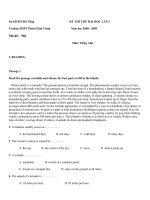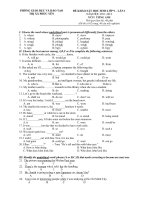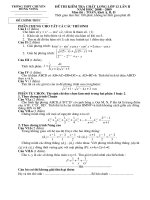Đề thi thử ĐH lần 1 năm học 2008- 2009 môn Tiếng Anh mã đề 982 và đáp án
Bạn đang xem bản rút gọn của tài liệu. Xem và tải ngay bản đầy đủ của tài liệu tại đây (126.41 KB, 12 trang )
Sở GD-ĐT Đà Nẵng KỲ THI THỬ ĐẠI HỌC LẦN I
Trường THPT Phan Châu Trinh Năm học 2008 - 2009
Mã đề: 982
Môn: Tiếng Anh
I. READING
Passage 1
Read the passage carefully and choose the best parts to fill in the blanks
What exactly is a tornado? The general picture is familiar enough. The phenomenon usually occurs on a hot,
sticky day with south wind and an ominous sky. From the base of a thunderhead, a funnel-shaped cloud extends a
violently twisting spout toward the Earth. As it sucks in matter in its path, the twister may turn black, brown or
even white. The moving cloud shows an almost continuous display of sheet lightning . It lurches along in a
meandering path, usually northeast ward, at 25 to 40 miles per hour. Sometimes it picks up its finger from the
earth for a short distance and then plants it down again. The funnel is very slender; its wake of violence averages
about 400 yards wide. As the tornado approaches, it is heralded by a roar as a hundreds of jet planes or thousands
of railroad cars. Its path is a path of total destruction. Buildings explode as they are sucked in by the tornado’s
low-pressure vortex ( where the pressure drop is as much as 10 percent ) and by its powerful whirling winds
( estimated at up to 500 miles per hour ). The tornado’s lifetime is as brief as it is violent. Within a few tens of
miles ( average about 16 miles), it spends its force and suddenly disappears.
1. Tornadoes usually occur on ………….. .
A. hot and humid days B. hot days C. cold days D. rainy days
2. The twister’s colour is caused by ………… .
A. the sun B. the colour of the sky C. snow D. what it picks up
3. A tornado …………….. .
A. meanders B. travels at a constant speed
C. travels in a straight line D. stays on the ground at all times
4. The speed of a tornado is ………….. .
A. 10 miles per hour B. 85 miles per hour
C. 25 to 40 miles per hour D. 25 to 40 miles per day
5. The average width of the path of the funnel is …………... .
A. the width of its finger B. less than 40 yards
C. 25 miles D. about 400 yards
6. The sound which announces the coming of a tornado is similar to that made by …………. .
A. vortex B. a diesel engine
C. thunder and lightning D. hundreds of jets
7. A building in the path of a tornado most likely would ………….. .
A. be partially destroyed B. be totally destroyed
C. lose its roof D. escape damage
8. According to this article, the winds of tornado ………….. .
A. are estimated at up to 500 miles per hour
B. drop the pressure 40 percent
C. have been clocked at 500 miles per hour
D. travel at 16 miles an hour
9. Usually a tornado is spent after traveling about ………….. .
A. 6 miles B. 16 miles C. 50 miles D. 400 yards
10. Implied but not stated …………. .
A. Tornadoes are caused by sheet lightning B. Nature is sometimes destructive
C. The tornado’s lifetime is as brief as it is violent D. A tornado is a supernatural phenomenon
Passage 2
Read the passage carefully and choose the best answer.
PARENTESE
Who talk more – men or women? Most people believe that women talk more. However, linguist Deborah
Tannen, who has studied the communication style of men and women , says that this is a stereotype . According to
Tannen, women are more verbal – talk more – in private situations , where they use conversation as the “glue” to
hold relationships together. But, she says, men talk more in public situations, where they use conversation to
exchange information and gain status. Tannen points out that we can see these differences even in children. Little
girls often play with one “best friend”, their play includes a lot of conversation. Little boys often play games in
groups; their play usually involves more doing than talking. In school, girls are often better at verbal skills, boys
are often better at mathematics.
A recent study at Emory University helps to shed light on the roots of this difference. Researchers studied
conversation between children age 3-6 and their parents. They found evidence that parents talk very differently to
their son than they do to their daughters. The startling conclusion was that parents use more language with their
girls . Specifically, when parents talk with their daughters , they use more descriptive language and more details.
There is also far more talk about emotions, especially sadness, with daughters than with sons.
11. Which sentence best expresses the main idea of the first paragraph?
A. It’s stereotype that women talk more than men .
B. Women talk more than men.
C. Women talk more in private , and men talk more in public
D. Little girls and little boys have different ways of playing.
12. Which word is similar in meaning to “glue” in line 4 ?
A. rope B. game C. sticky substance D. means
13. Which sentence best expresses the main idea of the second paragraph?
A. An Emory University found that parents talk more with their daughters than with their sons
B. Researchers have studied the conversations of children ad their parents.
C. Parents do not talk much about sadness with their sons.
D. Study at Emory University can help to explain the differences between communication styles of boys
and girls.
14. Which of the following phrases best explains the meaning of the word “verbal”?
A. deriving from verbs B. using very loud noise
C. being very talkative D. connected with the use of spoken language
15. The word they in line 4 refers to
A. women B. men C. situations. D. men and women
16. Which can be used as a synonym of the word “feelings” ?
A. worries B. anger C. emotions D. thinking
17. Which of the following statements can be inferred from the first paragraph ?
A. Men are more sociable than women.
B. Men and women have different styles of talking , which may begin in childhood.
C. Women talk more in some situations, men talk more in others.
D. According to Deborah Tannen, the belief that women talk more is partly right but most wrong and
oversimplified.
18. Which word could best replace “startling”
A. annoying B. surprising C. interesting D. beginning
19. Which of the following statements can be inferred from the second paragraph?
A. Boys don’t like to be with their parents as much as girls do.
B. Parents don’t enjoy talking with their sons as much as with their daughters.
C. A recent study found that parents talk differently to their sons and daughters.
D. Girls have more practice discussing sadness than boys do.
20. Which of the following statements is True about the passage?
A. Parents use more language to talk with their daughters. ]
B. Boys don’t like showing their emotions.
C. Girls are thought to be more talkative than boys.
D. Parents give more love to their daughters than their sons.
Passage 3
Read the passage carefully and choose the best parts to fill in the blanks.
If you can roll a ball, you can play bowls. Everyone can play: young and old, men and women, the fit and the not
so fit. It is the (21)………….outdoor game that really is a sport for all. What other sports can grandparents play
on equal terms with their grandchildren? What other game is so simple that you could take up it today and be (22)
…………in the national championship tomorrow?
Simple? Perhaps that is not the (23)……….…..word. There are bowls players in their thousands (24)
…….……will tell you that, although bowls is a game that anyone can (25)…….…… in five minutes, it takes a
lifetime to (26)…………. it. They are the people who have developed a passionate interest in the game .(27)
………….for outsiders, bowls is another word, and a strange and puzzling one. They see a bowl game in action
and wonder what is going on.
What the players are trying to do is easy to explain. Their (28)………… is to roll their bowls, called
wood, as near as possible to the little white ball, called the jack. If one of your bowls finishes nearer to the jack
than your opponent's, you score one point and he or she scores (29)………... If you have the two nearest, you
score two, and so on. The skill involved in rolling a bowl that weighs around 2 kilos across about 40 meters so
that it stops only a very short (30)…………..…. from the target is just as impressive as the skills required in
other sports.
21. A. special B. one C. alone D. individual
22. A. entering B. precisely C. competing D. accurately
23. A. right B. genuine C. just D. suitable
24. A. when B. whose C. which D. who
25. A. see through B. pick up C. catch on D. find out
26. A. tame B. manage C. master D. control
27. A. However B. Although C. Unlike D. Besides
28. A. point B. attempt C. scheme D. aim
29. A. something B. anything C. nothing D. everything
30. A. extent B. distance C. range D. length
Passage 4
Read the text below and decide which answer (A, B, C, or D) best fits each space
FRIDAY THE THIRTEENTH
Police are hunting for a hit-and-run driver who knocked a teenage cyclist off her bike in East Street. Sarah
Tucker, 17, had a lucky escape on Friday, 13
th
May, when she was sent reeling by a black Volvo on her way home
from work.
She bruised her thigh and shoulder and her bicycle was (31 ) ………….The driver stopped for a moment but
then drove off without (32 ) ………….. a name or address and before Sarah could get his number. “ I tried to get
out of his way, but I couldn’t,” she said.” Everyone at work kept going on about it being Friday 13
th
. I’m not a bit
(33)……….and wouldn’t change any of my plans just because Friday 13
th
is supposed to be unlucky, I don’t
usually take any (34 ) ……. of that sort of thing but I will now. I think I’ll stay in bed.”
The accident (35)…………at the junction with Westwood Road at about 6.30pm as Sarah was making her (36)
………….home to the Harley Estate.
The Volvo pulled out of Westwood onto Henley Road in front of the teenager’s bicycle. “ He could
at ( 37)………. have helped her up. I don’t see why he should get away with it,” said her father, Derek, “ Sarah
was lucky. I don’t know why the driver didn’t see her. He can’t have been (38)……….. attention. It is unfortunate
that nobody took down the number .” Though still too (39)…………to ride a bike, Sarah was able to go back to
(40)……….in Marlow on Monday.
31. A. damaged B. harmed C. devastated D. crashed
32. A. noting B. presenting C. leaving D. suggesting
33. A. irrational B. superstitious C. unreasonable D. prejudices
34. A. notice B. consideration C. note D. care
35. A. came about B. turned up C. finished up D. took place
36. A. route B. way C. course D. path
37. A. once B. most C. least D. best
38. A. giving B. paying C. attracting D. providing
39. A. discouraged B. confused C. overcome D. shaken
40. A. work B. job C. post D. Employment
II. PHONETICS
-Which underlined part has different pronunciation from the others?
41. A. student B. stupid C. studio D. study
42. A. chemist B. cheap C. child D. chair
-Which word has the different stress among them?
43. A. alternative B. satisfy C. continent D. India
44. A. holiday B. implement C. diagnose D. investigate
45. A. independence B. education C. impractical D. entertainment
III. VOCABULARY
-Choose the correct part to complete the sentence
46. Many organizations have been set up and funds have been................
A. raised B. bought C. risen D. raise
47. She won the award for ………….her whole life to looking after the poor.
A. paying B. devoting C. causing D. attracting
48. Microwaves are used for cooking, telecommunications, and …………….
A. to diagnose medically B. diagnosed medically
C. medical diagnosis D. medical diagnosing
49. I couldn’t ………….them when we climbed the mountain.
A. keep out of B. keep up with C. keep away from D. keep on with
50. It seems impossible to …………..terrorism in the world.
A. put stop to B. put an end of C. put an end to D. stop at
51.The director retired early ................. ill-health.
A. on account of B. ahead of C. on behalf of D. in front of
52. He sat down, .................. his shoes, and tilted back to relax.
A. pulled off B. took out C. pulled up D. took off
53.The disappearance of one or several species may result in the loss of ................... .
A. biology B. biography C. biodiversity D. biochemistry
54.What university will you take an ……………..examination into?
A. entrance B. attendance C. entry D. admission
55. Mary cannot afford tuition ……………..for studying abroad
A. fine B. fee C. finance D. Pension









